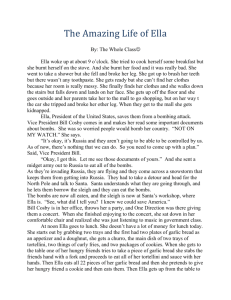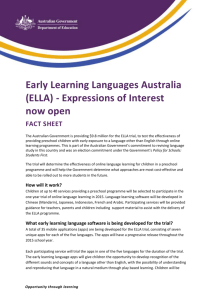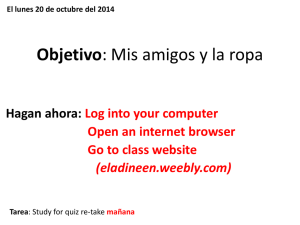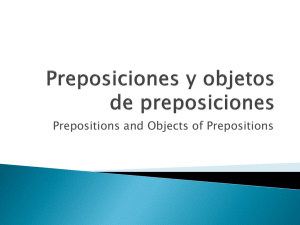KLIK
advertisement
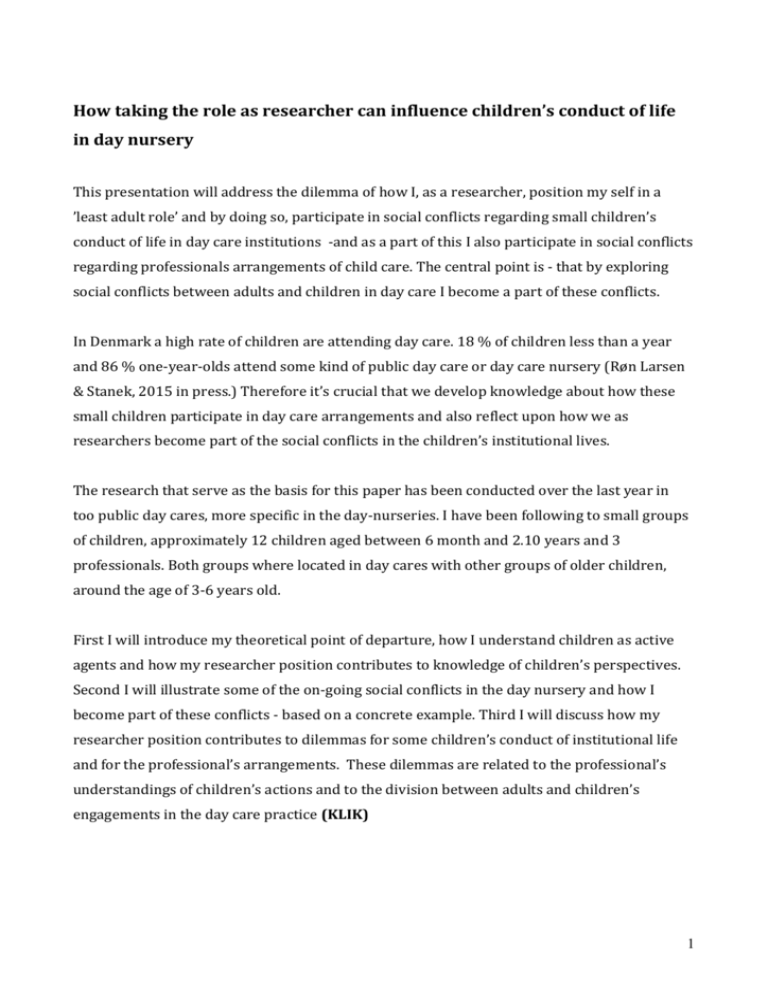
How taking the role as researcher can influence children’s conduct of life in day nursery This presentation will address the dilemma of how I, as a researcher, position my self in a ’least adult role’ and by doing so, participate in social conflicts regarding small children’s conduct of life in day care institutions -and as a part of this I also participate in social conflicts regarding professionals arrangements of child care. The central point is - that by exploring social conflicts between adults and children in day care I become a part of these conflicts. In Denmark a high rate of children are attending day care. 18 % of children less than a year and 86 % one-year-olds attend some kind of public day care or day care nursery (Røn Larsen & Stanek, 2015 in press.) Therefore it’s crucial that we develop knowledge about how these small children participate in day care arrangements and also reflect upon how we as researchers become part of the social conflicts in the children’s institutional lives. The research that serve as the basis for this paper has been conducted over the last year in too public day cares, more specific in the day-nurseries. I have been following to small groups of children, approximately 12 children aged between 6 month and 2.10 years and 3 professionals. Both groups where located in day cares with other groups of older children, around the age of 3-6 years old. First I will introduce my theoretical point of departure, how I understand children as active agents and how my researcher position contributes to knowledge of children’s perspectives. Second I will illustrate some of the on-going social conflicts in the day nursery and how I become part of these conflicts - based on a concrete example. Third I will discuss how my researcher position contributes to dilemmas for some children’s conduct of institutional life and for the professional’s arrangements. These dilemmas are related to the professional’s understandings of children’s actions and to the division between adults and children’s engagements in the day care practice (KLIK) 1 2. Theoretical point of departure The analytical approach is informed by an understanding of children as active agents with intentions and engagements in their everyday lives. Children are seen in a dialectic relation as subjects participating in societal contexts in which they learn and develop (as Pernille Juhl just elaborated) (Osterkamp & Schraube, 2013). This implies that children are understood as subjects from a first person perspective, learning and developing by taking part with other children (Højholt, 2006, 2008a; Juhl, 2014; Osterkamp & Schraube, 2013). Children pursue social activities and they cope with and change the world at the same time. Children conduct their life in collaboration with other children and adults and in relation to different matters in their lives (Chimirri, 2014, Dreier, Højholt & Kousholt, 2015 Juhl, 2014 Røn Larsen & Stanek). Through children’s conduct of institutional life they develop their own way of taking part in the child communities and through this participation they contribute to the professionals social practices (Højholt, Kousholt, Røn Larsen, Stanek, 2015?). The theoretical framework and my research methods are intertwined. I gain knowledge from the children’s perspectives, by participating with the children and taking part in the children’s institutionalized lives. This implies that I look at the every day life in the day nursery, from the children and their points of view. (KLIK) 3. Researcher position inspired by ’least-adult role’ – a way to access the children’s perspectives To be able to do this my participation with the children I am inspired by Nancy Mandells term ‘least adult role’. The ‘least adult role’ is a position where I do not act like the children or the professionals. ’Least adult role’ is to be understood as ‘(…)undertaking a responsive, interactive, fully involved participant observer role with the children in as least an adult manner as possible. This entailed neither directing nor correcting children’s actions.’ (Mandell, 42, 1991). 2 Why I have chosen to position my self in a ‘least adult role’ is because it is a way to get access to the children’s perspectives (Cosaro 1985, Mandell, 1991, Warming 2011, Davies 2014). Taking a researcher position inspired by ‘least adult’ makes it possible to come closer to the children’s engagements in the ‘day- care practice’ where adults and a children are supposed to participate differently and separated (which I will elaborate further). By being mainly reactive, waiting for the children to approach me and avoiding a more disciplinary stance towards the children, I am also identifying more with the children than with the professionals (Cosaro, 1985; Mandell, 1991; Epstein, 1998). One could say that I am learning from the children rather than about the children. (KLIK) To illustrate how I become ‘a least adult’, in the view of a child (from the nursery), I will give a small example. A group of children, the professional Sara and my self, are present in the wardrobe after being in the playground. The children are taking off jackets and shoes before entering the room in the day nursery. Some children are helping the other children. Karen (aged 2,3) approaches me. She asks ‘can I help you take off your shoes?’ I smile and respond ‘thank you but I can manage my self.’ It seems to me that Karen thinks of me as someone that might need help like the rest of the children. Karen does not ask if she can help the professional, Sara, who is also present in the wardrobe. It seems like I am not addressed as another professional adult but as someone in between. By being a part of the social situations in the children’s everyday life, I gain knowledge about what is important from the children’s perspectives. (KLIK) It is therefore essential that ‘Children’s perspectives must be explored in relation to their conditions for taking part different places.’ (Højholt, 205, 2012) 3 By joining the children and following them around, I am able to see how they pursue things, how they are directed at something and how they negotiate the conditions for their activities (Højholt, 211, 2012). Thereby I can come closer to an understanding of the children’s personal reasons for actions in their situated interplay (Kousholt, 2011; Højholt, 2012). Still it is important to note that my researcher position, is not settled once and for all in the beginning at my research. On the contrary I must negotiate how I can conduct my research and are able to explore the children’s engagements without taking a more familiar role as a professional adult. (KLIK) This example shows how I must also negotiate with the children about how to take part in their activities. I am sitting with some of the children looking in a book. One of the boys, Peter (aged 2,3) looks at one of the girls Emma (aged 1,8). She is trying to grab another book from the bookshelf. Peter looks at me and points to Emma saying ’look…not allowed’. Peter looks at me as if he expects me to do something and to set Emma right. I respond, ‘ I see what Emma is doing. You must call for another adult if you think it’s not allowed.’ This example shows that it is not possible to escape the expectations from children towards me taking a more familiar role as professional. Why I am (also) met with these expectations as a familiar professional, may be related to the professionals arrangements- and their different understandings of what a child and an adult are supposed to act like, in a day nursery. I will further show, how my researcher position both challenge and re-produce this division between adults and children’s engagements. (KLIK) When I enter the day nursery, I enter a practice that are many-sided and are intertwined by contradictory understandings of the children and their development. My participation as a researcher makes some of the on-going social conflicts within the practice visible. When I enter the practice I become a part of these different conflicts about the children (Højholt, Kousholt, 2015). 4 By taking part in the day nursery from a position as least adult, I enter an arrangement where children and adults act and are expected to act very differently (Kousholt, 2011). Differences between adults and children are marked both by size and also by expectations towards how to participate (Kousholt, 2011). Children and adults’ participation are often separated in the day nursery. The adults are supposed to ‘support’ the children’s interplay and at the same time leave the children to play with each other, while the adults engage in talks with other adults. There seems to be an understanding that, when adults participate with the children in their interplay, the adults may pull children away from what they are directed at. The adults are positioned as someone that may disturb children’s interplay instead of adults being a part of the children’s interplay (Kousholt, 2011). This division are connected to an understanding of learning as something adults organize for children and further that children’s free play is something that adults are not suppose to interfere with. Taking a position as a least adult, engaging with the children in their activities –I acknowledge that to explore the children’s engagements, I must distance myself from being a familiar adult and thereby I reproduce the division between adults and children’s engagements. At the same time I also challenge the division between adults and children’s engagements – simply because I am engaging with the children and I am still recognized as an adult from the professional’s perspective. Other contradictions that seem to be a part of the practice in the day nursery are related to how the professionals understand children’s engagements as connected to their possibilities for taking part in the social practice. As a part of preventing children from being marginalized, some children are ‘pointed out’ as having difficulties and thereby in need of professional support. When children are understood as having difficulties, attachment theoretical understandings, focusing on children’s developmental ‘defects’- seem to be dominant (Stanek, Røn Larsen, 2015). Therefore the educational activities with these children are often arranged as compensative interventions, directed at developing the skills that the children seem to lack. From this compensatory perspective it seems difficult to understand children’s participation in relation to their possibilities for taking part in a social practice (Højholt, 2012). 5 With this point of departure I would like to introduce an example where professionals describe a child as fragile, as highly sensitive, and as a physically challenged child. These descriptions seem to influence how the everyday life in the day nursery is arranged. What I would like to illustrate is how the child’s personal agency and my personal agency, due to my position as researcher, are entangled in the professionals arrangements and conflicts about the child (Højholt, Kousholt.. 2015). I will now tell you a story about Ella. Ella’s is a little girl (aged 1,5). Before Ella began in the day nursery, the professionals in the nursery had been handed down some individually centred notions (from a physiotherapist and a psychologist) regarding Ella as having difficulties. These difficulties were understood as connected to the fact that Ella was not walking and she appeared shaky in her movements when she arrived at the day nursery. In addition she lacked language skills. Ella was from the beginning very interested in me when I participated with the children in the day nursery. When I entered the day nursery, Ella watched me and followed me around most of the day if possible. Because of the professional’s understanding of Ella as a fragile and physically challenged child, the professional’s where afraid that Ella wouldn’t be directed at the other children, but mainly at me. They were worried that Ella would become too attached to me. This concern I could understand, but soon it became clear to me, that Ella was socially very active, and that she did engage in social activities with the other children. I will now show you an example about how my researcher position is entangled in the professional’s arrangements with Ella. (KLIK) An example We are out in the playground. One of the professionals, Line provides Ella with a small motorcycle. Line tries to motivate Ella to drive on the motorcycle. Ella drives away and she starts to follow Selma. I place my self near a sandpit. Selma arrives at the sandpit. Ella follows. Selma looks to investigate her motorcycle and she looks at me. I ask her, if she needs some petrol. Selma smiles and nods. I pour sand over a part of the motorcycle, pretending its petrol. Both Selma and Ella participates in the arrangement by patting the sand. Now Selma is ready to drive again and she drives away. Ella stays on her motorcycle next to me for a few minutes. I am thinking that 6 maybe she also wants some petrol on her motorcycle. Then Line comes and asks Ella, if she wants to drive again? Ella does not answer the question. Line tries to pull Ella’s motorcycle and thereby make Ella drive. Ella sits still, looking at Line. I explain to Line that Ella was following Selma and that the to girls were playing and putting petrol on their motorcycles. Line responds ‘Ohh I see’ and smiles. Line moves away from the sandpit and Ella drives after Selma. (KLIK) This situation illustrates how the professional and I are standing in very different positions in the practice and thereby have different possibilities for understanding Ella’s participation. One could state that different kinds of knowledge are produced in different positions in the practice (Axel; Højholt, Kousholt, 2015, Røn Larsen 2011). In this situation I am not just acting as ‘least adult’ – I also become ‘more adult’ trying to support the children’s engagements. I am, as a researcher, actively engaged in the children’s interplay. I contribute to the children’s arrangements and at the same time I challenge this division and separatedness between adults and children’s engagements in the practice of the day nursery. Thereby I both support Ella’s engagements with Selma and I contribute to the disruption of Ella’s engagements. The social conflicts about the child -understanding Ella as passive and too attached to adults lead to personal problems for the child (preventing her from participating with Selma). (KLIK) One could say that Ella’s engagements are overlooked or seems invisible from Lines point of view. Danish researcher Charlotte Højholts points that ‘When we overlook the social complexity of the children’s everyday life ordinary difficulties become abstract’ (Højholt, 2015). The professional’s notions of Ella as fragile and passive overshadow their possibilities to see Ella as a socially active and directed child. Thereby the professionals, when trying to motivate Ella to participate in the social activities, they also prevent Ella from exploring what she wants with whom she wants. This division between adults and children’s engagements in day-care seem to result in an abstract understanding of children’s difficulties and a lack of insight into the child’s 7 participation as linked to the context. KLIK From this point of departure I will return to the central dilemma of this presentation - How I, as a researcher, explore social conflicts and also become a part of these conflicts. By taking a researcher position as least adult, I place myself in the dualism, where adults and children are opposites in the day nursery – and at the same time I try to challenge this dualism. By developing a researcher position that tries to transcend being a familiar adult, I gain knowledge about what matters to the children and also what is at stake for the professionals. Still my position as researcher is entangled in the professional’s arrangements and conflicts about the children, and thereby I become a part of these conflicts that I research. I therefore find it crucial that we, as researchers, reflect upon how we become part of the social conflicts that we research. Thank you for listening References (to be continued…) Chimirri, (2013) Investigating media artefacts with children: Conceptualizing a collaborative exploration of the sociomaterial conduct of everyday life. Ph.d. afhandling ved forskningsprogrammet Hverdagslivets socialpsykologi, RUC. Dreier, O. (2011)Personality and the conduct of everyday life I: Nordic Psychology, vol. 63 (2), 4-23. Dreier, O. (2008) Psychoterapy in everyday Life. Cambridge University Press. Epstein (1998) are you a girl or are you a teacher? The least adult role in research about gender and sexuality in a Primary School. 8 Holzkamp, K. (2013). Psychology: Social Self-Understanding on the Reasons for Action in the Conduct of Everyday Life. In E. Schraube & U. Osterkamp (Eds.), Psychology from the Standpoint of the Subject: Selected Writings of Klaus Holzkamp (pp. 107-137). Basingstoke: Palgrave Macmillan. Holzkamp, K. (1998): ”Daglig livsførelse som subjektvidenskabeligt grundkoncept.” Nordiske Udkast, 26, 2, 3-31. Højholt, C & Kousholt, D. (2015) Parental collaboration in relation to children’s school life… Højholt (2011) Børn i vanskeligheder, Samarbejde på Tværs. Dansk Psykologisk Forlag. Højholt (2012) Communities of children and learning in school In: Children, Childhood and Everyday Life (red.) Marianne Hedegaard, Karin Aronsson m.fl. Juhl, P. (2014) På sporet af det gode børneliv: Samfundets bekymring og børns perspektiver på problemer i hverdagslivet. Ph.d. afhandling ved forskningsprogrammet Hverdagslivets socialpsykologi, RUC. Kousholt, D. (2011) Børnefællesskaber og familieliv. Dansk Psykologisk forlag. Larsen, M, R. (2012) A paradox of inclusion…In: : Children, Childhood and Everyday Life (red.) Marianne Hedegaard, Karin Aronsson m.fl. Larsen, M. R. & Stanek (2015-in press). Young Children and their Conduct of Everyday Life. Nordic Psychology. Larsen, M,R. & Stanek, A. (2014) Young children and their conduct og everyday life In: Nordic Psychology-special Issue, ’Psychological Perspectives on Children’s conduct og everyday life. Lave, Jean (2015) Situated learning. Historical Process and Practice. Mandell, Nancy (1991) The least adult role in studying children. In: Studying the social worlds of children. Ed. By Frances Chaput Waksler. Warming (2011) Børneperspektiver. Professionsserien. Akademisk forlag 9

